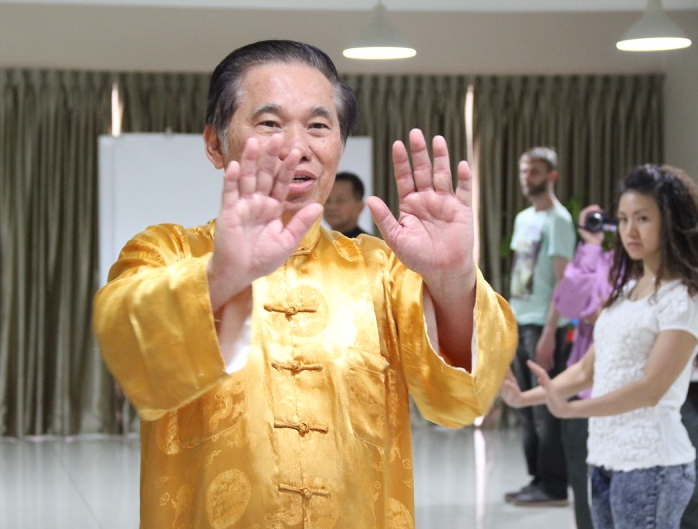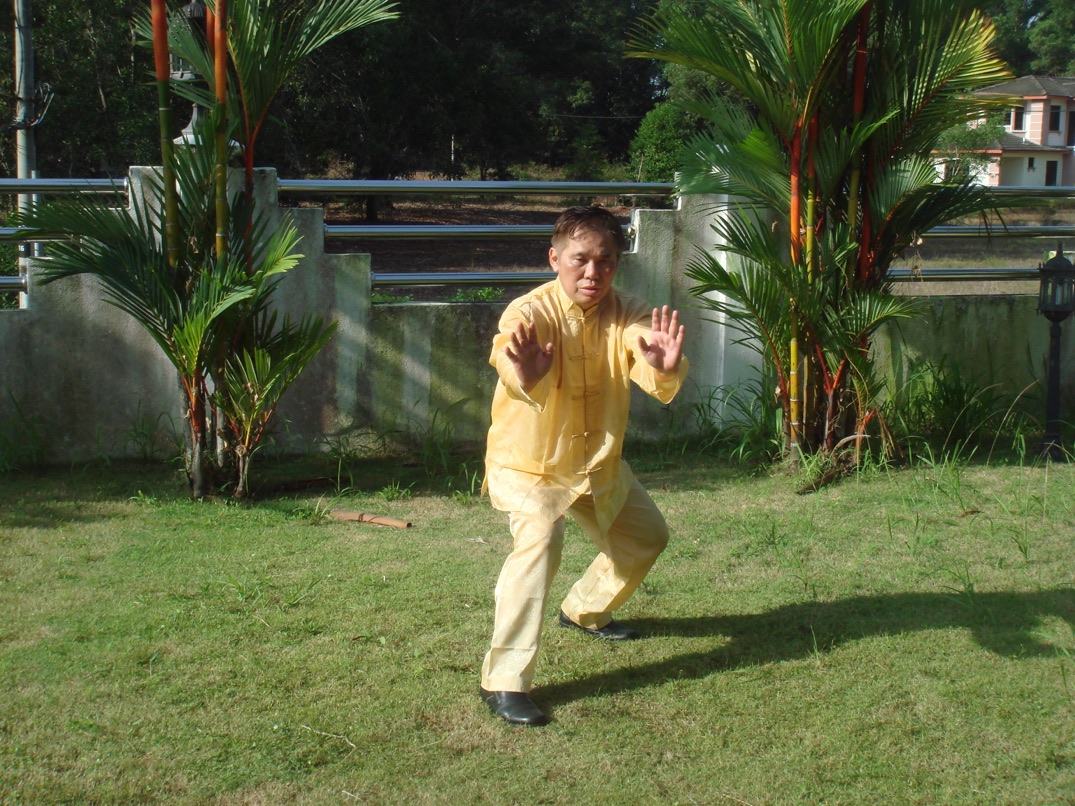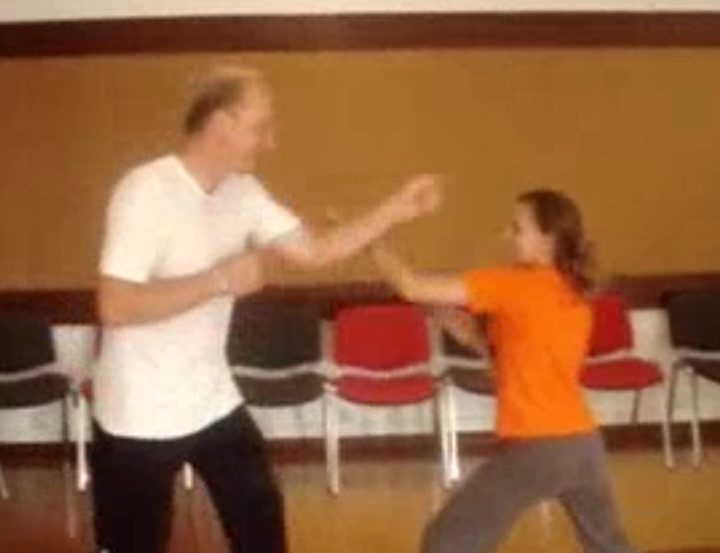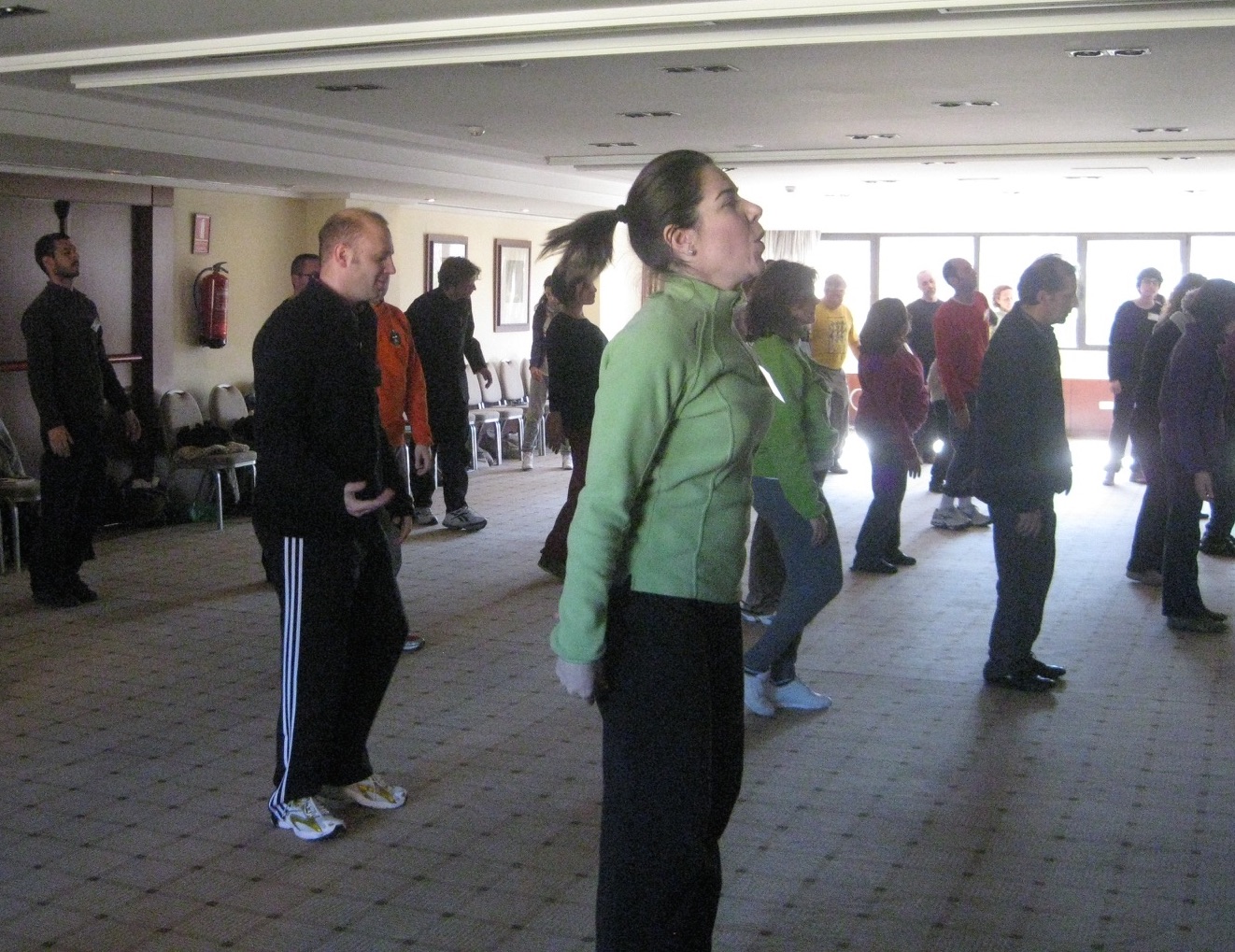SELECTION OF QUESTIONS AND ANSWERS
FEBRUARY 2016 PART 3

Grandmaster Wong explaining how to perform "Pushing Mountain" correctly during an Intensive Chi Kung Course in Kuala Lumpur in 2015
Question 1
Sifu, you emphasize again and again that those who wish to overcome their so-called incurable disease, including cancer, should practice mainly what they learned on the first day of your Intensive Chi Kung Course. Exercises like what you taught on the second and third day are advanced and powerful, and should be attempted by sick students once a while to maintain their skills.
I thought that sick people should practice powerful chi kung so that they could recover faster. Did I miss something important?
— Eric, UK
Answer
Yes, you missed something very important. But your mistaken concept is common amongst many people. Many people think, wrongly, that sick people should practice powerful chi kung to get well quickly.
A useful image to keep in mind is as follows. Teaching sick people powerful chi kung is like asking them to run marathons or lift heavy weights. It will aggravate their illness. Even healthy people need to train systematically before they can successfully run marathons and lift heavy weights.
According to chi kung masters in the past, chi kung may be divided into five levels as follows:
- Medical chi kung.
- Health chi kung.
- Chi kung for philosophers.
- Chi kung for warriors.
- Spiritual chi kung.
The lowest level is medical chi kung, which is used for overcoming pain and illness. The next level is chi kung for health, practiced by healthy people to enhance their daily performance.
The next two higher levels are chi kung for philosophers and for warriors, or chi kung to enhance scholastic performance and chi kung to enhance martial art performance. Warriors' chi kung is rated higher than philosophers' chi kung because while both philosophers and warriors need a lot of energy and mental clarity, the demand of warriors is greater.
If a philosopher lacks energy or mental clarity, he is a bad philosopher. If a warrior lacks energy or mental clarity, he may be a dead warrior.
Unfortunately, many martial artists today exhibit a glaring lack of mental clarity. While good health and self-defence are the two cardinal aims of any martial art, many martial artists today are unaware that their practice not only do not help them to fulfill their aims but actually make their health worse and they submit themselves routinely to be punched and kicked by their classmates!
Many students attend my Intensive Chi Kung Course with the primary objective of overcoming their illness. Why, then, do I teach what they need on the first day, and teach advanced exercises that they do not presently need on the second and the third day?
It is because there are also many other healthy students attending the course with aims of peak performance and spiritual cultivation. It is also because I want the course to be comprehensive, ranging from a basic level to a master's level.
It is indeed incredible that students attending the course will learn in just a few days skills ranging from the basic to a master's level, like entering into a chi kung state of mind and generating energy flow that enable them to practice chi kung effectively, to progress to tapping energy from the Cosmos and to develop internal force for peak performance in their daily life, and to culminate in expanding into the Cosmos for spiritual cultivation.
It is a course for both beginners and masters. Indeed, many masters in our school repeat taking this course.
Question 2
The San Zhan set in Wuzuquan is famous for internal force. I have practiced it for a year, but I do not feel any internal force.
— Cheong, Malaysia
Answer
In my early years about 1967 to 1969 I practiced San Zhan for two years but I did not develop any internal force. I learned Wuzuquan from Sifu Chee Kim Thong, who was a world acknowledged patriarch of Wuzuquan, and regarded as a living treasure of the People's Republic of China. In fact I practiced San Zhan in his house in Dungun in Malaysia. Sifu Chee Kim Thong did not teach us personally. We were taught by his eldest son, Sifu Chee Boon Leong.
But there was no doubt that my seniors had a lot of internal force, and they developed their internal force from San Zhan. In fact San Zhan was virtually all we practiced, followed by Kneading Hands, where we went over the routine of San Zhan in pairs. When Sifu Chee Boon Leong or a senior placed his arm on mine, I could not move it away. Occasionally we practiced seven-star knocking arms and meditation in Guan Yin poster.
I did not ask my seniors how long they had been practicing San Zhan. I guess it could easily be more than 10 years. The Wuzuquan school was exclusive, and we practiced in secret. I was very lucky to be accepted as a student.
On hindsight, I did not develop internal force in my two years of San Zhan training because I did not have the necessary skills. I did not know about this important fact at that time. I guess my seniors did not know the fact too, or else they would have told me and taught me the skills. They were very kind people, for which I was grateful.
Then, how could they have a lot of internal force if they did not know the fact that skills were needed, besides the right techniques, to develop internal force from San Zhan training? They acquired the skills unknowingly due to their dedicated practice over a long time. That is the reason why it takes years to develop internal force.
An example will make these points clear. Suppose 10,000 units of force are required before a practitioner can said to have substantial internal force. Whenever he applies the right techniques and the right skills in his training, he develops 100 unites of internal force per session. So he needs 100 sessions to accumulate 10,000 units of internal force if these sessions are consecutive so that he can add 100 units each session.
If he trains everyday, which is what internal force practitioners do, it does not mean that he will accumulate 10,000 units of internal force after 100 days. This is because even when his techniques are correct every time he trains, which is usually the case as techniques are visible and he knows them, he may not have the right skills as skills are invisible and he does not know about the skills. But because of his dedication, conditions may sometimes become ideal that these skills occur without his knowing.
Suppose these ideal conditions occur 3 times a month, with an interval of 10 days in between where no internal force is developed. This does not mean that he will acquire 300 units of force in one month because the intervals where no force is developed are far apart that force previously developed would have been dissipated. Hence, this practitioner will end up with only 100 units of internal force after each month of daily practice.
But as he progresses in his training, the ideal conditions when internal force can be developed will become more frequent. Suppose after 3 years of daily training, he can develop 500 units of force every month. He needs 20 months to develop 10,000 units of internal force. Thus, this practitioners take about 5 years to develop substantial internal force.
This estimate, of course, is not exact. We suppose that when conditions are ideal the practitioner will develop 100 units of force, and after 3 years the ideal conditions become more frequent that he can accumulate 500 units of force each month. But he may develop more or less than 100 units of force, take more or less than 3 years for ideal conditions to be more frequent, and accumulates more or less than 500 units of force each month. But the estimate gives a clear, quantitative picture of what happens.
If students know the skills besides knowing the techniques, they will take a shorter time. If the skills are transmitted to them from heart-to-heart they can start developing internal force continuously on the very first day. This is what I shall do in the coming Wuzuquan course in France in 2016. This explains why our students in Shaolin Wahnam take 100 days to develop the amount of internal force what others may take 5 years.

San Zhan is a wonderful set
Question 3
San Zhan is a very important set in Wuzuquan, but there are no combat applications in the set. Is it necessary to learn other sets to learn combat application?
Answer
Every pattern in San Zhan can be used for combat. The combat application in San Zhan is complete by itself. This means that the patterns in San Zhan alone are sufficient to handle any attack, without the need to borrow techniques from other sets or other martial arts.
Hence, it is not necessary to learn other sets or other martial arts to be combat efficient. This does not mean that it is not useful to learn other sets. As an analogy, if you have a car, it is sufficient as a vehicle of transport, but this does not mean that it is not useful to own other cars.
At first I also thought that a Wuzuquan practitioners need to learn other sets for combat application. I thought wrongly that San Zhan was only for developing internal force. What would a San Zhan practitioner do if a Taekwondo exponent gives him a round-house kick? Or what would he do if a Judo exponentt attempts to throw him onto the ground? Initially, despite my rich experience in combat, I could not find any patterns in San Zhan that could be used against these attacks.
Then, in a flash of inspiration, I realised that San Zhan itself is complete in combat application. Just by practicing San Zhan a skilful exponent can use its techniques to counter any attack! This realisation greatly enriched my understanding of combat.
San Zhan is not only complete in combat application. It is a complete martial art. By practicing San Zhan alone and nothing else, a practitioner can develop a lot of internal force, can handle any attack, and enjoy good health, vitality, longevity, mental clarity and spiritual joys. It is a wonderful art.
But not many people understand its depth. Not many people even know how to use San Zhan to develop internal force, the benefit for which it is most famous. The coming Wuzuqhan course in France in 2016 is where the depth and wonders of San Zhan will be taught.
Some people may think that I wasted my time practicing Wuzuquan for more than two years. I had no internal force, for which Wuzuquan is famous, and I was not aware of any combat application of the San Zhan set I practiced. Indeed for more than two years I only practiced San Zhan and nothing else, except some occasional knocking arms and sitting meditation,
But these two years of my Wuzuquan training were very important to me. They enabled me to relax totally when practicing kungfu, which I learned later is essential in developing internal force. The simplicity of San Zhan techniques enabled me, also later, to understand the depth of combat application. Developing force and combat application are the two pillars of any kungfu training, and I had my foundation of these two pillars during my two years of Wuzuquan training, for which I am very grateful.
Question 4
I will attend one of your kung fu courses. This seems important.
I feel like it's a battle to get relaxed and even more so to stay relaxed. I try to relax from head to toe like you taught me, but find that if I don't pay attention the tension quickly creeps back in and my thoughts start to wander all over the place.
— Lee, USA
Answer
It is good that you intend to attend one of my kungfu courses. The best kungfu course for you to attend is the Intensive Shaolin Kungfu Course or the Intensive Taijiquan Course. Please remember that Taijiquan is kungfu, i.e. a martial art, a fact that most Taiji practitioners today, especially in the West, do not realize.
I just conducted an enjoyable and rewarding Intensive Shaolin Kungfu Course in Kuala Lumpur recently. Due to my tight schedule I have not planned to hold any other Intensive Shaolin Kungfu Course or Intensive Taijiquan Course this year. But you can attend any of my regional kungfu courses in various parts of the world.
You need to have some prior kungfu experience to attend my kungfu courses, otherwise you will not be able to follow the course.
Learning kungfu in our school is a good way to be relaxed. It is interesting to note that many martial artists in other schools are physically tensed and mentally stressful. Of course, this statement is never meant to belittle them. I am only stating a fact. Whether they believe it is their right and their business.
Another way you can learn to be relaxed is to learn Taiji from a local Taiji school in your area. (These Taiji practitioners do not consider themselves as martial artists, which is correct as they cannot apply their Taiji techniques for combat.) But you must be careful not to hurt your knees. It is notorious that many Taiji practitioners have knee problems, because, in my opinion, these Taiji schools teach stances wrongly. Correct teaching will result in benefit, not harm.

The Taijiquan training system in our school is different from that in other schools
Question 5
Do many Americans or perhaps even Westerners complain often to you about finding it difficult to succeed in relaxing? For some reason I find that as I apply the "don't worry" strategy, I succeed for a moment and then catch myself intellectualizing in an attempt to stay focused and relaxed. Do I need to just persevere and overcome it. I have been trying to relax and be spontaneous but I'm really wrestling with this.
Answer
When I first taught overseas many years ago, I was very surprised when Westerners, including Americans, told me that they could not relax. Now I am no longer surprised, because I have found that it is a common problem. But those who learned from me or from any certified Shaolin Wahnam instructors, soon found out that they could relax.
To be relaxed is actually simple, although for many people today, like you, it may not be easy. If you don't do anything, in particular if you do not tense your muscles and do not intellectualize, you will be relaxed.
Yes, you need to spend time to undo your bad habit, which is common in Western societies, of tensing your muscles and of intellectualizing. Eventually you will be able to relax.
If you try to relax or try to be spontaneous, you are not relaxed or spontaneous. Don't try, just do it. The more you try, the more you will wrestle with the attempt.
As an analogy, if there is some delicious food which you wish to eat, don't try to eat it, just enjoy eating it.
Question 6
When I met you in Ireland a couple of years ago you said that I should be a sifu.
— Name withheld, UK
Answer
You are grossly mistaken.
I have never considered you as a candidate for a Shaolin Wahnam instructor. When you suggested to me your idea of becoming a Shaolin Wahnam instructor I told you politely on 2nd February 2015 that:
"It is our school policy to appoint instructors according to seniority and usually recommended by the Chief Instructor of the country. As there are many students more senior than you, it is unlikely that you will be appointed."
Either you failed to get my suggestion or chose to ignore it. You kept insisting stubbornly to become one, and I repeatedly told you that you were not considered, until I had to tell you point-blank on 10th November 2015 that:
"Honestly I have never considered you to be a potential instructor."

The onus of chi kung is practice, not theoretical knowledge
Question 7
I sacrificed a lot of money, I spend 1200 euros on the course. I don't think I'll be getting that back! I gave up my career in accounting. Are you going to issue me with a refund?
Answer
No, I am not going to issue you a refund. A refund is given to those who are unsatisfied with my courses, and ask for it within an hour the course ends, not for those not appointed an instructor.
Compared to the benefits you get from the courses, the money you paid was little. The first regional course you attended was in Ireland. In your own words, you said on 2nd February 2015 before attending the Ireland course:
"I have had so many difficulties in life. I suffered 10 years of depression. I was stuck for a long time. Many more problems."
You were happy with the Intensive Chi Kung Course held in Kuala Lumpur in March 2015. After returning home you wrote to me on 24th March 2015:
"have arrived back home safe and sound, thank you for the wonderful course."
Later you reported to me on 22nd August:
"I feel very lucky to be practicing Chi Kung, since I started nearly 4 years ago, my health is so good now."
It is telling on your character that despite the many benefits you have obtained from attending the chi kung courses, you now ask for a refund, presumably because you are not appointed an instructor despite being told all along.
I specifically told you that attending my courses did not mean you would be appointed an instructor. I also advised you not to give up your accounting, but if you give it up for any reasons, it is your business.
Question 8
I asked you if you can just get me some more reading information so I can improve.
Answer
Your question above indicates one of the many reason why you are not even considered to be a Shaolin Wahnam instructor. You have failed to understand our philosophy, which is practical beneifts, not just theoretical knowledge, though we realize that theoretical knowledge can lead to practical benefits.
If you have read my writings on my website, which any aspiring instructor would do, you would have realized that a main reason chi kung has been grossly debased today is that many chi kung teachers have theoretical knowledge but not practical benefits.
More reading information on chi kung gives you theoretical knowledge. Attending courses taught by competent teachers gives practical benefits, which you yourself have experienced when you overcame your years of depression and illness.
I would give you a piece of parting advice. Be grateful of these benefits. If you choose to be ungrateful, you may eventually lose them. It is not that God punishes you for being ungrateful, but due to your own thinking and doing. Goodness always bring goodness, and evilness always brings evilness. This is a universal truth.
LINKS
Selected Reading
- History and Philosophy of San Zhan of Wuzuquan
- Crane Flying through Clouds
- Shaolin Wahnam Policy on Challenges
- Learning Combat Sequences for Free Sparring
- Is Qigong Practice Real? Is Eating Food Real?
